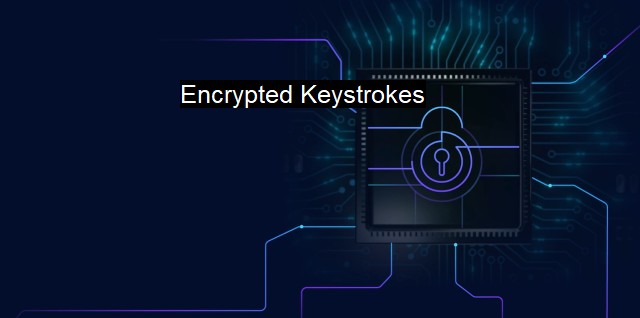What are Encrypted Keystrokes?
The Importance of Encrypted Keystrokes in Cybersecurity: Protecting Sensitive Information Online
Encrypting keystrokes refers to the process within cybersecurity where every key entered into a device is encoded to prevent cybercriminals from decrypting the information, offering an alternative solution to secure against keyloggers, without slowing down computers or requiring updates. The technique for encrypting keystrokes has been in existence for a long time, but its usage has surged due to the rise in cyber-attacks around the world.Keystroke encryption is a deterministic algorithm that secures the transmission of every single key that is typed, from the keyboard to the application or browser, implementing a new character for each key that is typed, safeguarding against malicious invasions like keyloggers. A keylogger is a type of surveillance technology utilized to capture and record individual keystrokes. Most keyloggers can track mouse clicks and even record screen activity, supplying hackers with a log of practically all computer activities.
Keystroke encryption works by disassociating the data by replacing the original letters, numbers and characters typed, with randomised alternatives that solely the receiving software recognizes and can translate back into its original form. When implemented properly, it proves effective in protecting user information from cyber theft that could occur through keylogging. It uses real-time protection technology to encrypt keystrokes at the keyboard driver level, detecting, scrambling, and encrypting every keyboard stroke.
Keystroke encryption does a superb job of preventing hardware keyloggers, software keyloggers, and kernel-based keyloggers from exploiting sensitive data. Hardware keyloggers are physical devices a hacker installs between the keyboard and the computer to capture keystroke data. Software keylogger, on the other hand, is a malicious software application that can record every keystroke on a system without the user's knowledge, intending to steal personal data like passwords and banking details. The Kernel-based keyloggers, undoubtedly the most critical, operates at the operating system's lowest level and can avoid detection from standard anti-keylogging software.
A robust tool against keyloggers, keystroke encryption is now recognized as an effective line of defense against data breaches. It is often used in conjunction with antivirus software to provide an extra layer of secure protection on computer systems, thereby minimizing the efficacy of keyloggers and prohibiting the chance for malware programs to hijack keystrokes, threatening user privacy.
Antivirus programs can sometimes fall short and fail to prevent a keylogger attack, making the use of keystroke encryption a must-have tool alongside antivirus solutions. Many antivirus programs today now include a keystroke encryption function. they focus primarily on signature-specific ciphers, which, while effective to a certain extent, fails against zero-day attacks. Keystroke encryption, on the other hand, is both proactive and reactive and can be implemented regardless of the type of potential cyber-threat.
While there are immense benefits to implementing keystroke encryption, it is not a standalone solution for the massive issue of cyber threats, and it should be seen as a preventive measure. It is, however powerful when paired with other cybersecurity tools like anti-malware ciphers, intrusion detection systems, and secure firewalls in securing all information.
Encrypted keystrokes provide a sophisticated disguise for all keystrokes right from inception, disrupting the path to unauthorized users - usually just before their success. While it is being recognized as an effective method for preventing sensitive keystrokes from falling into the wrong hands, it is even more powerful when woven into security software suites, used in combination with other cybersecurity tools. Keystroke encryption is becoming a prevalent tool in the fight against cyber-crimes and, when practiced correctly, certainly earns its place within the cybersecurity field.

Encrypted Keystrokes FAQs
What are encrypted keystrokes?
Encrypted keystrokes refer to the process of securing the input entered on a device by encoding it in a way that can only be deciphered by authorized parties. This is done to keep the information entered on a device safe from hackers and cyber threats.How do encrypted keystrokes protect against keyloggers?
Encrypted keystrokes protect against keyloggers by ensuring that the keystrokes are unreadable and unusable by the keylogger. Even if a hacker gains access to the keystrokes entered on a device, they will not be able to read them because they are encrypted.What are the benefits of using encrypted keystrokes in antivirus software?
Encrypting keystrokes in antivirus software can help protect sensitive information such as passwords, credit card numbers, and other personal data from being stolen by hackers. This feature ensures that information is protected throughout the entire process of entering it into a device.Is it possible to decrypt encrypted keystrokes?
It is possible to decrypt encrypted keystrokes, but only by those who have access to the decryption key. This is why encrypted keystrokes are considered to be a secure method of protecting sensitive information.| | A | | | B | | | C | | | D | | | E | | | F | | | G | | | H | | | I | | | J | | | K | | | L | | | M | |
| | N | | | O | | | P | | | Q | | | R | | | S | | | T | | | U | | | V | | | W | | | X | | | Y | | | Z | |
| | 1 | | | 2 | | | 3 | | | 4 | | | 7 | | | 8 | | |||||||